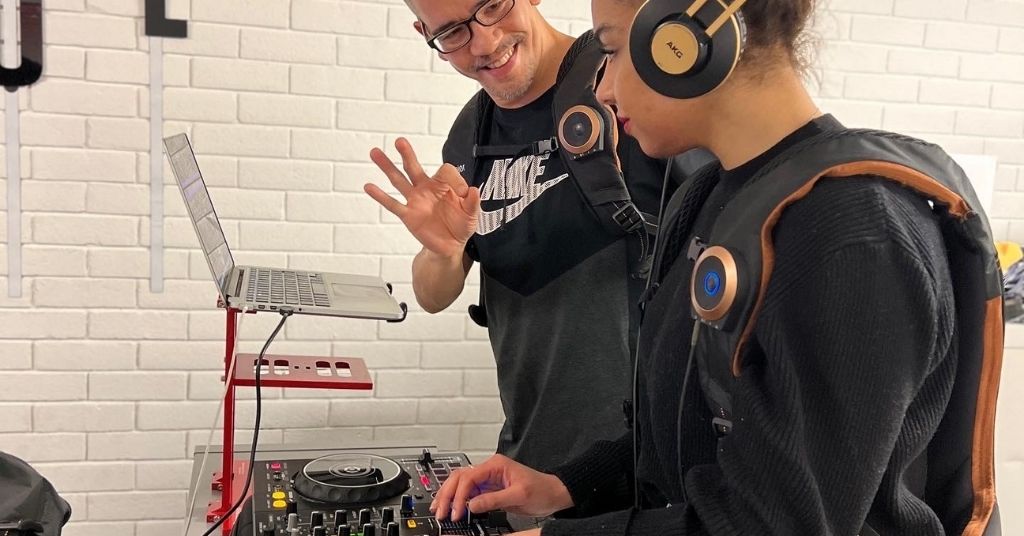
Deaf singer Mandy Harvey gives an unforgettable performance on AGT finals
September 20, 2017
After tragedy, musician Sam Baker ‘became an artist’ with hearing loss
September 21, 2017A Tragic Turn To Music Success: Q&A with musician Sam Baker

Sam Baker is an internationally recognized folk musician and recording artist from Texas who lost his hearing in a tragic, violent and wholly unexpected way:
While traveling by train to Machu Picchu in Peru in 1986, a bomb placed on a luggage rack above his head by the Shining Path guerrilla group exploded, killing seven passengers including three people who had been sitting with him. Baker was left with numerous injuries, including brain damage, a cut artery, and blown-in eardrums, leaving him deaf in on ear, limited hearing in the other and a persistent, intense case of tinnitus. His injuries required 17 reconstructive surgeries. The fingers of his left hand were left badly damaged, but over time he was able to grasp a guitar in his other hand and return to music.
Despite his history and challenges, Sam has gone on to music success, with his 2013 album “Say Grace,” being named one of the top 10 country music albums of 2013 by Rolling Stone Magazine.
As a fellow musician with hearing loss, I am taken by Sam’s story, especially how he has rebuilt himself to make music again. I had the wonderful opportunity to talk to him about his story:
Q&A with musician Sam Baker
Stu: Sam, can you first tell us what the extent of your hearing loss/challenges is?
Sam: On my left side, I have 100 percent loss. On the right side I’m not sure of percentage, but it’s significant. I can boost my hearing with a hearing aid, which I wear daily. My tinnitus is wildly loud, always. Sometimes even louder.
Stu: How long was it before you were able to hear what you needed to hear to make music?
Sam: I could feel music more than hear it – with my ear drums blown in. In the hospital I had a tape driven thing and could turn music up very loud. I never heard details but I could feel it.
Stu: What does it mean that your ear drums were blown in and how was that resolved?
Sam: The blast blew in both eardrums. I had three ear drum replacements – timpanoplasty – two of them worked.
Stu: What ear tech do you wear? Do you use additional hearing assistive technology?
Sam: In the studio, I wear headphones. During live performances, an Ultimate ear-molded in-the-ear monitor. At home/on the road, a hearing aid.
Stu: Do you have tinnitus on both sides of the brain? Is it at a consistent volume and intensity? Intermittent?
Sam: Yes, it wildly varies by the time of year, what I have eaten, stress levels, and sometimes it changes because it changes.
Stu: Your bio says you took up songwriting after Peru and your many surgeries. Why songwriting? Were you planning a music career prior to that time?
Sam: I wrote songs before the blast but they were awful. Awful! After, I tried to write the story of the explosion and it would never say what I wanted it to say. A melody came and stayed in my head and that melody married a line that came to me. The line was: “sitting on the train to Machu Picchu / the passenger car explodes.” The song became “Steel.” That was when I became a songwriter. Really that is when I became an artist. Like I found words and texture. Sound is a texture. As is canvas.
“That was when I became a songwriter. Really that is when I became an artist. Like I found words and texture. Sound is a texture. As is canvas.”
Stu: Did your experiences in Peru and after inspire you to make music or to write prose/poetry/lyrics or both? Or were you already engaged in those activities prior?
Sam: Compelled more than inspired.
Stu: How long did it take you to start playing your guitar left-handed?
Sam: Several months. My hand may or may not still have been in bandages. But there were so many hand surgeries.
Stu: How long did it take for you to succeed at playing it?
Sam: I am not there yet. I can do some basic things. I just switched to electric guitar for most of my shows. I can hear it better and play fewer notes because of the sustain (the electric guitar provides.)
Stu: What did it take from you to retrain yourself and your brain to do that?
Sam: Persistence. And more persistence. And friends and family who were loving and supportive. No one can do anything like this alone. It was a group effort.
Stu: Do you have family or children?
Stu: No wife or kids, but saying that, hearing impairment is isolating. I try to resist and it is one of my missions to get people who are losing their hearing to get hearing aids and to consciously fight the isolation.
“…hearing impairment is isolating. I try to resist and it is one of my missions to get people who are losing their hearing to get hearing aids and to consciously fight the isolation.”
Stu: During your recovery and healing you must have experienced both interesting and frustrating moments along the way. Care to expound upon them?
Sam: As they say about many things, long periods of quiet boredom punctuated by short periods of agony and ecstasy.
Stu: I have strong memories of the moment I knew that I could put the pieces of my musical self together again – my hearing, my tech and my art. Do you remember the moment you realized that you could make music again?
Sam: As above, when the song “Steel” finished. No one is just an observer. The same bell tolls for the served and the server. Back to group effort.
Stu: How does the hearing loss/tinnitus influence your music making on your own, in the studio, in performance?
Sam: I don’t take joy in the sound like I used to. For me now the sound needs context. The sound of the cello is not enough anymore because it comes from so far away and in through a tiny speaker, like my hearing is now a cheap transistor radio. With my hearing aid in, it is like having a less cheap transistor radio in. I have found that my in-the-ear monitor is very good, as is an in-the-ear noise-canceling sound device. Those are not like I used to hear but I can sometimes take pleasure in sound again.
“I don’t take joy in the sound like I used to. For me now the sound needs context.”
Stu: What kind of adjustments have you learned to make to compensate for your hearing challenges and/or your tinnitus?
Sam: I orient to whomever I am talking to. I avoid loud places if I can. I try to remember to not isolate, to withdraw from life. I talk too loud. I sing too loud.
Stu: You sometimes craft spoken-word melodies. How does that change the music, your performance, the meaning of the songs?
Sam: I don’t know. It is something I feel. Maybe it started when I turned the music up so loud and sent it into my head without any eardrums. That is a good question. I have not thought of that before. It was sound going direct to the ear canal.
Stu: I find the spoken word to melodies to be very profound. In fact, my auditory trainer and mentor has suggested the same approach to me though I can work within pitch in the studio and increasingly live. Has your pitch been impacted by your hearing challenges?
Sam: Yes, I don’t hear myself well enough to compensate. Saying that, I am finding that an in-the-ear monitor is magic. It pushes away all clutter noise except the feed from the board and my tinnitus.
Read more: How hearing rehabilitation can help deaf musicians
Stu: Has making music with your challenges – physically, emotionally professionally – made those challenges or making music any easier? More profound? More satisfying?
Sam: I am compelled to do what I do for whatever reason. For me, words like “easier,” “profound,” “satisfying” don’t really apply. I do it because I have to. Like, dislike, love, hate, treasure, disdain – labels don’t seem to help me. I just do.
Stu: You say you were not “born to the art world.” Whats did you mean?
Sam: I was born on the prairie into people that had jobs and worked, worked, worked for their entire lives. They did what they felt was their job. Just like I do. Really, just like almost everyone I have ever met. People who do their jobs, take care of the family and friends, and like those people in South America who ran on board the train to save the lives of strangers. Just like the people in Manchester who ran toward that mess to try to make things better. Most of the people in the world are just like that. That is what I have found. Kind and good.
“Most of the people in the world are just like that. That is what I have found. Kind and good.”
Stu: You travel and perform and I assume make a living from that. I know the routine and the struggle to keep going. How do you keep yourself going financially as an artist?
Sam: Persistence and the belief that I am doing what I am supposed to be doing. Everything else falls into place.
Thanks so much for talking to us, Sam!
Listen to Sam’s new album, “Land of Doubt” on SoundCloud.



